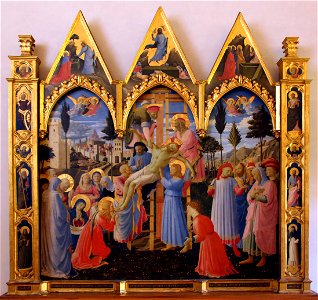This work was originally commissioned by palla strozzi from lorenzo monaco, for the sacristy of the church of santa trinità in florence, but by the time of monaco's death only the pinnacles of this work had been painted. When angelico took over the commission he found himself confined by monaco's ready-made triple-arched gothic frame. He ignored these constraints, however, making use of the three arches to provide an expansive tuscan landscape. The work is painted on one panel and the three arches find an echo in the placing of the figures in three groups. In the distance at the left arch the road begins to wind up to jerusalem, shown as tuscan hill town. The city fortifications appear as a series of cubes, pillars, and walls massed together in a sharply defining light. Buildings of widely varying sizes, shapes and colours are arranged together within the city walls. At the top of the hill rises a citadel-like temple. Outside the city gates lies a landscape of ploughed fields, farmhouses, and hedgerows. In the sky, above a storm cloud is gathering which throws shadow over half the city. The whole is viewed through a screen of trees, which mark out the middle distance in the complete picture. The central arch is largely blocked off by the wooden framework of the cross and two ladders. The cross bar of the former appears to run behind the picture frame hinting at further, obscured space. With no scene behind but the sky and the work of timber, the eye is drawn to the body of christ which is at the very centre of the picture. Angelico challenges the tendency of the other two arches to define the shape and space of the work by placing a strong vertical, in the form of a tower or a tree, in the corners of each. The pilasters on either side of the frame contain twelve panels with full length portraits of saints, and eight medallions with portrait busts. The full-length figures are shown standing on columns which are each painted with careful attention to the view-point of the spectator. Mary magdalen kneels before christ kissing his feet. The virgin kneels, her hands clasped, head on one side in reflective misery, with an air of particular detachment. She is partly screened from the viewer by the winding sheet held before her. The other holy women stand in positions of contemplation or prayer; one wipes a tear from her eye. As in earlier paintings by angelico, the sense of the space in which the virgin kneels is created by placing figures in a circle around her. Object Type: painting, altarpiece. Genre: religious art. Date: between 1423 and 1432 Early Renaissance (1420s–1500). Dimensions: height: 275 cm (108.2 in) ; width: 285 cm (112.2 in). Medium: tempera and poplar wood on panel. Depicted People: Jesus, Joseph of Arimathea, Nicodemus. Collection: Museum of San Marco. Beato angelico, pala strozzi della deposizione, con cuspidi e predella di lorenzo monaco, 01
Loading...
